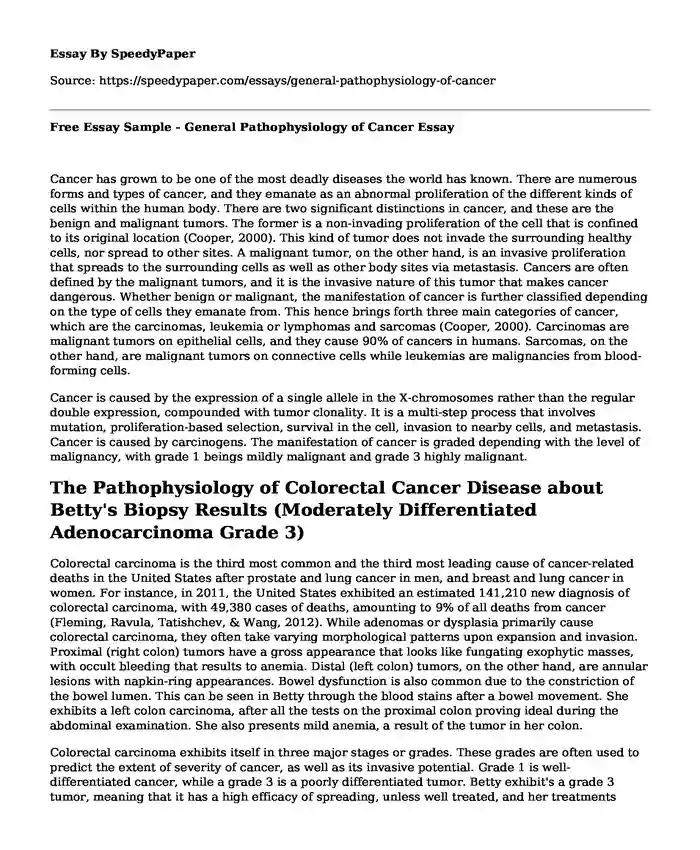Cancer has grown to be one of the most deadly diseases the world has known. There are numerous forms and types of cancer, and they emanate as an abnormal proliferation of the different kinds of cells within the human body. There are two significant distinctions in cancer, and these are the benign and malignant tumors. The former is a non-invading proliferation of the cell that is confined to its original location (Cooper, 2000). This kind of tumor does not invade the surrounding healthy cells, nor spread to other sites. A malignant tumor, on the other hand, is an invasive proliferation that spreads to the surrounding cells as well as other body sites via metastasis. Cancers are often defined by the malignant tumors, and it is the invasive nature of this tumor that makes cancer dangerous. Whether benign or malignant, the manifestation of cancer is further classified depending on the type of cells they emanate from. This hence brings forth three main categories of cancer, which are the carcinomas, leukemia or lymphomas and sarcomas (Cooper, 2000). Carcinomas are malignant tumors on epithelial cells, and they cause 90% of cancers in humans. Sarcomas, on the other hand, are malignant tumors on connective cells while leukemias are malignancies from blood-forming cells.
Cancer is caused by the expression of a single allele in the X-chromosomes rather than the regular double expression, compounded with tumor clonality. It is a multi-step process that involves mutation, proliferation-based selection, survival in the cell, invasion to nearby cells, and metastasis. Cancer is caused by carcinogens. The manifestation of cancer is graded depending with the level of malignancy, with grade 1 beings mildly malignant and grade 3 highly malignant.
The Pathophysiology of Colorectal Cancer Disease about Betty's Biopsy Results (Moderately Differentiated Adenocarcinoma Grade 3)
Colorectal carcinoma is the third most common and the third most leading cause of cancer-related deaths in the United States after prostate and lung cancer in men, and breast and lung cancer in women. For instance, in 2011, the United States exhibited an estimated 141,210 new diagnosis of colorectal carcinoma, with 49,380 cases of deaths, amounting to 9% of all deaths from cancer (Fleming, Ravula, Tatishchev, & Wang, 2012). While adenomas or dysplasia primarily cause colorectal carcinoma, they often take varying morphological patterns upon expansion and invasion. Proximal (right colon) tumors have a gross appearance that looks like fungating exophytic masses, with occult bleeding that results to anemia. Distal (left colon) tumors, on the other hand, are annular lesions with napkin-ring appearances. Bowel dysfunction is also common due to the constriction of the bowel lumen. This can be seen in Betty through the blood stains after a bowel movement. She exhibits a left colon carcinoma, after all the tests on the proximal colon proving ideal during the abdominal examination. She also presents mild anemia, a result of the tumor in her colon.
Colorectal carcinoma exhibits itself in three major stages or grades. These grades are often used to predict the extent of severity of cancer, as well as its invasive potential. Grade 1 is well-differentiated cancer, while a grade 3 is a poorly differentiated tumor. Betty exhibit's a grade 3 tumor, meaning that it has a high efficacy of spreading, unless well treated, and her treatments hence aid in this.
One of the Chemotherapeutic Treatment Available For Betty.
In many cases, surgical operations and removal of tumors have been the conventional therapeutic interventions for patients with cancer. However, there are also other options for the use of chemotherapy. Chemotherapy can be administered intravenously through injections or pumps, as well as orally in the form of pills. Two forms of chemotherapy exist depending on the stage of cancer. Palliative chemotherapy is administered in advanced stage cancers where the spread is too wide for surgical removal, while adjuvant chemotherapy is administered once a surgical operation has been done to eliminate any cancerous cells that might have been missed. This is the form of chemotherapy relevant to Betty. One chemotherapy treatment she could undergo is the administration of 5-Fluorouracil (5-FU), used in combination of vitamin leucovorin and administered intravenously. This intervention is, however, linked with the reduction in voluntary physical activity, and hence, fatigue (Mahoney, Davis, Murphy, McClellan, Gordon, & Pena, 2013). It is also linked to anemia.
References
Cooper G. M. (2000). The Cell: A Molecular Approach. 2nd edition. Sunderland (MA): Sinauer Associates. The Development and Causes of Cancer. Available from: https://www.ncbi.nlm.nih.gov/books/NBK9963/
Fleming, M., Ravula, S., Tatishchev, S. F., & Wang, H. L. (2012). Colorectal carcinoma: Pathologic aspects. Journal of gastrointestinal oncology, 3(3). Pp. 153-173. doi:10.3978/j.issn.2078-6891.2012.030
Mahoney, S. E., Davis, J. M., Murphy, E. A., McClellan, J. L., Gordon, B., & Pena, M. M. (2013). Effects of 5-fluorouracil chemotherapy on fatigue: role of MCP-1. Brain, behavior, and immunity, 27(1). Pp. 155-161. doi:10.1016/j.bbi.2012.10.012
Cite this page
Free Essay Sample - General Pathophysiology of Cancer. (2023, Jan 27). Retrieved from https://speedypaper.com/essays/general-pathophysiology-of-cancer
Request Removal
If you are the original author of this essay and no longer wish to have it published on the SpeedyPaper website, please click below to request its removal:
- Free Essay on Statistics and Probability Practice Problems
- Business Model Essay Sample
- Free Essay Example on Preventing Rehospitalization
- MIF Environmental Assessment Toolkit, Essay Sample
- Free Essay - Factors Affecting Internet Use in American Population
- How the Media Is Biased Towards Progressive-Liberal Values. Paper Example
- Paper Example: Depression and Risk of Heart Disease Mortality
Popular categories





